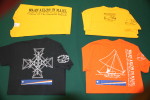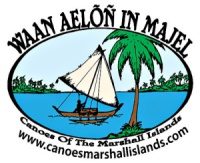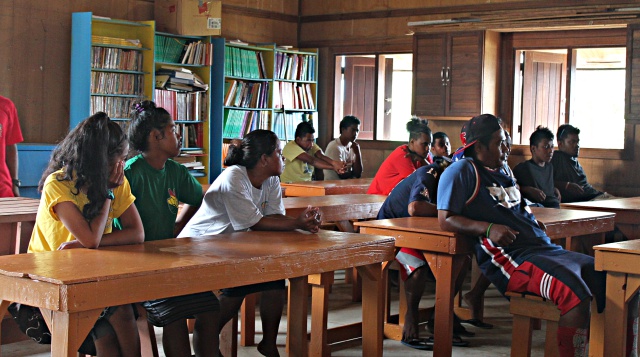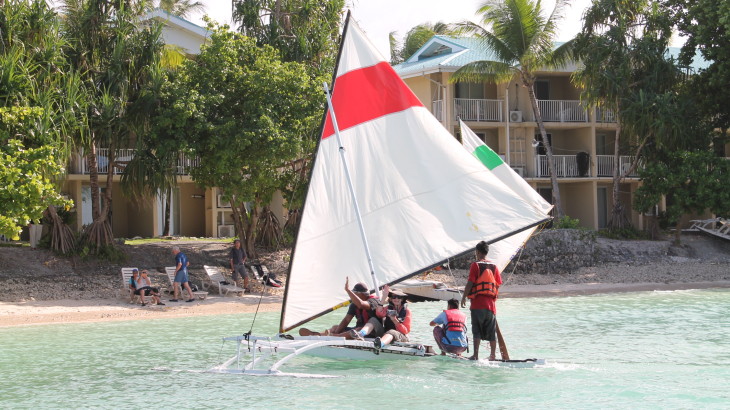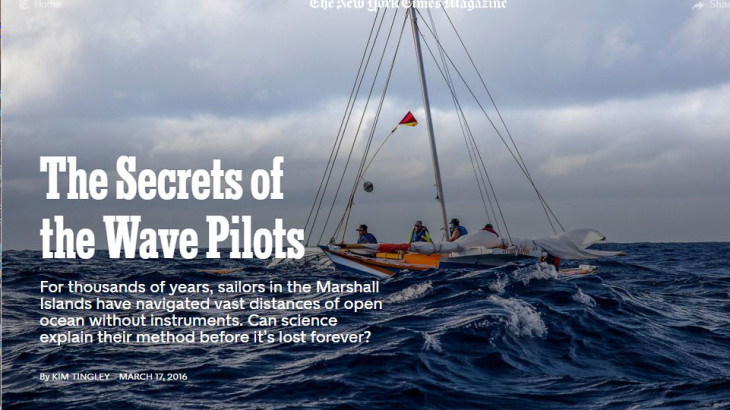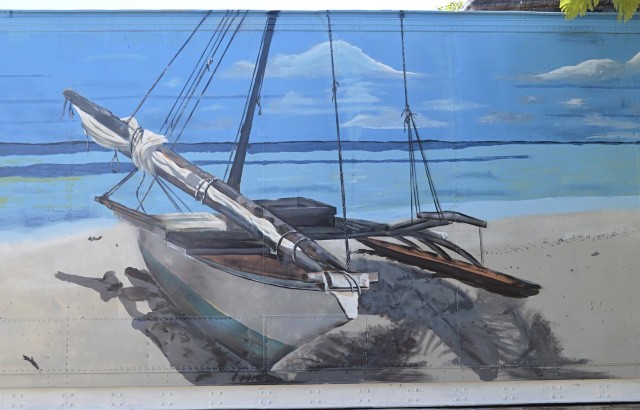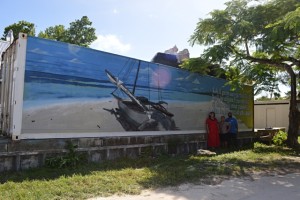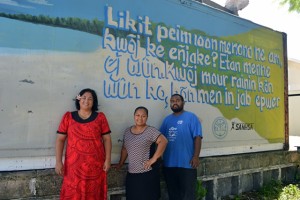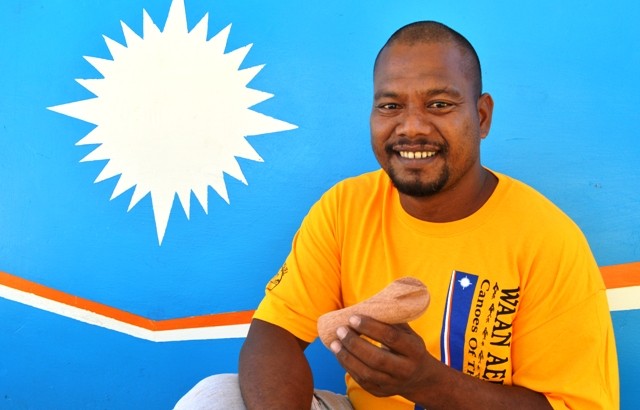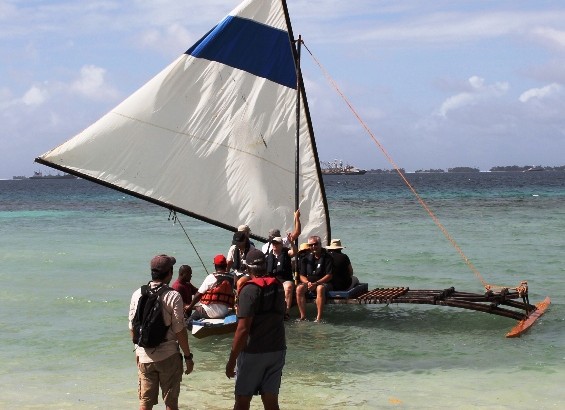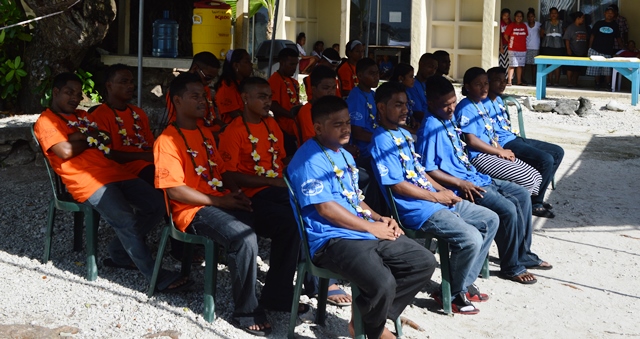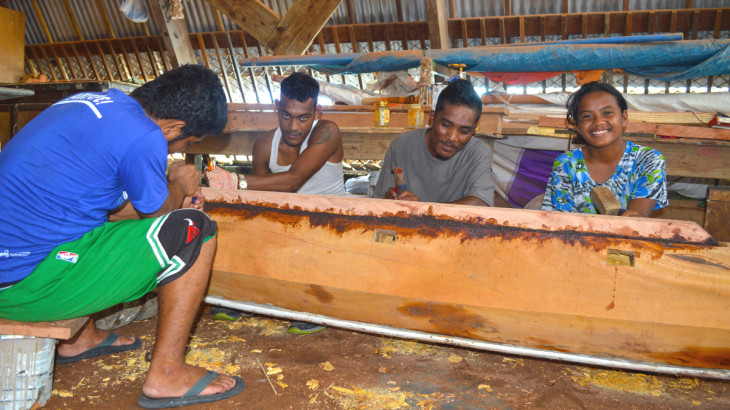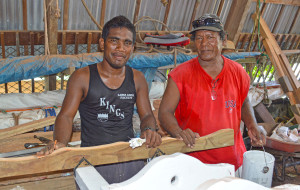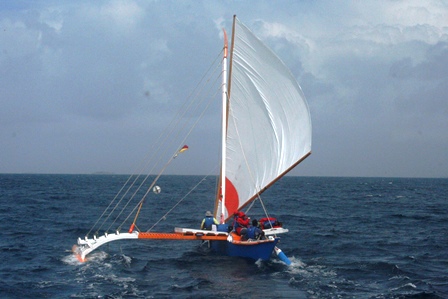“On the morning of Thursday, June 18, the wind was about 10 knots from the east and Alson said at 10am ‘Let’s go!’”
By Karen Earnshaw
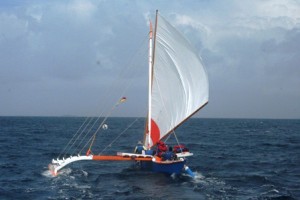
Smooth sailing in Majuro lagoon as Jitdam Kapeel heads for the pass. Photo: WAM
It has taken 10 years, but master navigator Captain Korent Joel’s vision of having scientists validate the method by which he pilots the waves of the Marshall Islands is now in motion.
John Huth, a physicist at Harvard University, Massachusetts, and a self-taught expert in navigation, and Dr. Gerbrant van Vledder, an oceanographer at the Netherland’s Delft University of Technology, were both recently in Majuro and met with Captain Korent to attempt to understand the technique he uses to move around RMI’s atolls.
In a related landmark event, the scientists also witnessed the second voyage of a Waan Aelon n Majel (WAM) ocean-going canoe from Majuro to Aur Atoll, 60 miles to the north, in June.
Joe Genz, the Assistant Professor of Anthropology at the University of Hawaii, Hilo, and a long-time visitor to RMI, has been working hard on Captain Korent’s vision and the canoe revival program with WAM director Alson Kelen. “I met Captain Korent in 2005 when I was here doing my PhD work. He said then that he wanted a scientist to validate what he knows to be true. Now, at last, we’re starting to make that happen.”
Joe was in Majuro last summer to work with Alson on the strategy for this year’s continuation of the navigation revival. “I arrived June 9, at which point the guys at WAM were finishing repairs to the canoe. The team leader was master canoe builder Binton Daniel and alongside him were Sear Helios, Linton Baso, and Elmi Juonraan.”
The 35-foot canoe is called Jitdam Kapeel, which loosely means ‘seeking knowledge’. It was used in a similar voyage to Aur in 2010. This year’s crew was led by Alson, who has been serving as Captain Korent’s apprentice,’ and included Binton, Sear, Elmi, Ejnar Aerok and Jason Ralpho.
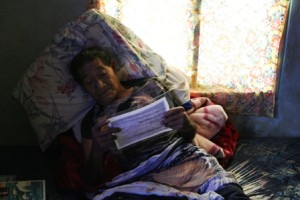
Captain Korent Joel studies paperwork brought by the scientists. Photo: WAM
The original plan was to have Captain Korent travel on the escort vessel, MIMRA’s Jebro, but sadly he was sick and was forced to stay home. “We needed an alternate plan,” Joe said. “It was either cancel the trip or try something else. Alson was very determined to make the trip and he had a lot of confidence they could do it because of the success of the 2010 voyage. Plus, John and I each had a GPS on the escort vessel to keep track of their route, so were confident everyone would be safe.”
The decision was made and by the time the scientists arrived in Majuro, the canoe was ready. ”We had everything we needed including life jackets and provisions and water for a voyage that would last 10 days,” Joe said. “We kept a lot of the food on Jebro.”
The voyage
“On the morning of Thursday, June 18, the wind was about 10 knots from the east and Alson said at 10am ‘Let’s go!’
“It was a scramble to get ready,” Joe said, “but finally the canoe left at 3pm. The scientists and I also left on Jebro at about the same time. Jebro was loaded with the supplies: chicken, ribs, Gatorade, rice and lots of vegetables. Some of these were to be a gift to the Aur community.”

Ejner Aerok, Jason Ralpho, and Sear Helios on the stern of the canoe. Photo: WAM

Jason Ralpho on board the Jitdam Kapeel. Photo: WAM

Elmi Juonraan helms the Jitdam Kapeel. Photo: WAM
The day was sunny and looked like a great day for sailing. “We all got to the pass at about 5pm. Then, as soon as we got out into the ocean, the wind picked up to about 15 knots. The waves were very erratic and stayed that way.
“All of us ri-belle on the Jebro were throwing up,” Joe grimaced.” It was a chaotic wind chop from east, a very violent motion.
“On the canoe, the crew was cold and tired. We could see from the escort vessel that the canoe was pounding into the waves and no-one could be in the front of the mast as there was so much water on the bow. The bow would dive into the waves. It was a jolting ride for them. They were wet, cold, and hungry.”
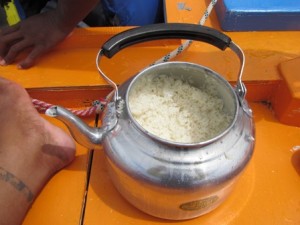
A precious teapot of rice cooked on a burner set under the deck. Photo: WAM
The crew had a little burner under the deck and they did manage to cook some rice.
The canoe and the chase boat communicated by VHF, but no details of the canoe’s location were transmitted. “Their course was pretty amazing as they tracked a little bit east of north.” Joe and the scientists were also surprised at how fast the canoe was travelling. “Alson had anticipated getting to the eastern side of Aur for safety. This is because he didn’t want to shunt (to move the sail) because in the waves it would have been too dangerous.
“I asked over the radio Alson where he thought he was when we came closer to Aur. We were worried that the canoe might hit the reef in the dark. But he described to me exactly the right spot. He said he was using sightings of the (stars of) Southern Cross. He described it to me as ‘guessing his way up to Aur’.”
At about 5:30am or 6am the next morning the two boats were 15 miles to the east of Aur. “Alson knew where to turn,” Joe said, “but going downwind was a problem because of the direction of the wind for the canoe. Eventually, the scientists and I knew that he knew where he was and where he was going, but the conditions were too difficult, so we eventually towed them in.”
In hindsight, had the canoe been able to perform better, they would have made it and gone over the north tip and into Aur’s northwest pass. As it was they sailed across the lagoon to Tobal on Friday, with the local community giving them a formal welcome ceremony with a feast and speeches. “The scientists thought they were in another world,” Joe said.

Jason Ralpho, Ejner Aerok, Sear Helios, Binton Daniel, Elmi Juonraan, and Alson Kelen in Aur. Photo: WAM
On Saturday the crews enjoyed relaxing, but some repairs were done to the canoe. “They fixed some lashings and replaced the main sheet and main halyard.” The team also installed a light on the mast to make it easier for the Jebro crew to see them at night.
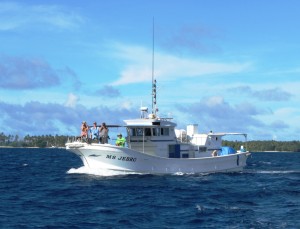
The MV Jebro, which acted as an escort boat on the voyage to Aur. Photo: WAM
“Sunday we left at about 2pm or 3pm in the afternoon, going out the southern pass. The wind was about 10 knots from north of east, then it died down. They had just a little bit of current flowing from east to west. Then, at about 2am the wind picked up. The course they ended up sailing was like an arc.”
Alson knew he needed to get upwind to make Majuro and he continued to do that. “At daylight we were 20 miles out and he was headed to Rongrong,” which is at the northwestern end of the atoll. “One of his guys worked out which island it was they could see and after that they went straight to the pass.
“The scientists were blown away. After leaving Aur, they had thought they were going to be way off course.”
After the voyage, Alson said the crew’s performance was excellent “and I’m really proud of myself and for the crew I chose. I borrowed the chief mate Jason from Shipping Corp. He’s been on the water all his life. He’s from Namdrik. Also, Sear did a great job on the helm. And Sear and Elmi made repairs. Binton is our elder … he’s from Ailinglaplap and has sailed all his life. Yes, it was a good voyage.”
The mystery of ‘dilep’
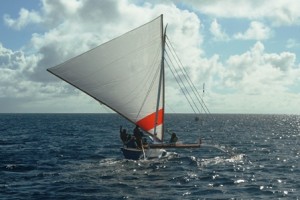
Jitdam Kapeel underway to Aur in June, 2015. Photo: WAM
Because Captain Korent Joel was sick with an infected leg, Joe, Alson, and the scientists John and Gerbrant visited him at his home in Rita, a village of Majuro. Alson and Joe were translating “but it was difficult to find the right words in Marshallese for the scientific descriptions of waves and currents,” Joe said. Key, however, was working out the English translation of the word ‘dilep’. “Korent explained that his system of navigation includes something called the ‘dilep,’ which is a sort of ‘backbone’ or a line between two atolls. It’s like a wave path and describes using it as wave piloting rather than navigating.”
In years past, Joe and other researchers have tried using wave buoys to search for the ‘backbone.’ “Korent describes it as two swells meeting each other forming a series of heaped of waves called booj, or ‘knots’, along a path and that they balance the canoe on this. We now think that maybe the instruments we were using weren’t sensitive enough to pick up the booj waves.”
Intriguingly, Korent said the ‘dilep’ system is not necessarily just for the Marshall Islands, stating he could use the system from, say, on a voyage from the Marshall Islands to Japan. “He says he can feel the ‘dilep’,” Joe said. “It seems he’s just higher tuned than other people to get a sense of what the water is doing.” While one would think to feel this one would need to be close to the water on a light canoe, but this is not so. “He can do this on a ship. He’s spent 40 years on transport ships and hospital ships and he uses his system of wave piloting.”
The scientists
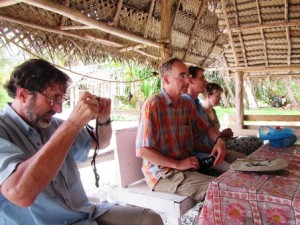
John Huth, a physicist at Harvard University, Massachusetts, and Dr. Gerbrant van Vledder, an oceanographer at the Netherland’s Delft University, in Aur. Photo: WAM
As a professor of anthropology at the University of Hawaii in Hilo, Joe Genz was at two international conferences giving talks on traditional navigation where he met the two scientists, Dr. John Huth and Dr. Gerbrant van Vledder, who joined him on the voyage to Aur in June, 2015. “The three of us had been having conversations about Marshallese navigation for a year or so,” Joe said. “Gerbrant and I met at an oceanography conference and John and I first met at an anthropology conference where I gave a talk on wave navigation. John has a passion for traditional navigation and Gerbrant is one of the top wave modelers in the world. I invited them to join the trip and they were very interested.”
For John a highlight of his visit to RMI was watching the voyaging canoe’s crew “using the stars as a natural compass and comparing the stars marking our passages to the waves and wind. The combination of the three were great to get into the shoes (or stomach) of the traditional navigators.
“In particular I remember lying on my back during the return voyage, eyes closed, feeling the chase boat respond to the waves, and making note of them, and then opening my eyes to see (the star) Altair pass close to our zenith.”
John is very impressed with the WAM program. “It is fantastic. I couldn’t have designed a better program. And the name of the boat Jitdam Kapeel is, I understand, a proverb meaning something like ‘seeking knowledge guarantees wisdom’. I try to pursue a similar philosophy in my course (at Harvard). As a mechanism to impart pride in Marshallese culture, it is excellent.”
John said he did not get the feeling of the ‘dilep’ on the voyage to Aur. “I understand it as Captain Korent has explained, and other explanations, and I have some possible hunches of what produces it, but I need to experience it as a navigator would experience it. On the voyage back from Aur, I’m told we followed a traditional route. This route, coincidentally, seems to have produced some of the wave-induced motions that are reminiscent of what I have heard of ‘dilep’.”
John’s co-adventurer, Gerbrant is a specialist in the research and development of ocean wave prediction models and metocean studies (meteorology and oceanography). “I have little experience with navigation on the open ocean,” he said, “but I have a knack for reading maps and the use of environmental information to find my position on land and to trace the routes taken. Two years ago I heard of the Marshallese method of wave piloting and I was immediately intrigued. My research brought me into contact with Joe Genz and John Huth, and I am very pleased to have been part of the expedition from Majuro to Aur and back.
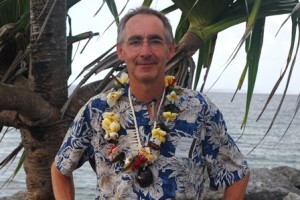
Dr. Gerbrant van Vledder, an oceanographer at the Netherland’s Delft University of Technology. Photo: WAM
“This trip had many highlights. The first was to travel on the open ocean during night time under the bright star-filled sky, and to experience the sunset and sunrise amidst the endless waves. The second was the exceptional reception by the people of Tobal on Aur Atoll. Their hospitality and their way of sharing was amazing. It made me aware of the many differences between our cultures.”
During the two voyages, “I tried to watch the waves to infer their characteristics. Although I could infer their main characteristics I failed to use it for navigation purposes. I still have much to learn.” On the WAM project, Gerbrant said he saw it “as a unique combination of preserving the cultural heritage of the Marshall islands and a social program to help the young generation ‘at risk’. I strongly support any initiative to keep WAM alive and to expand their working area of building canoes and teaching to sail them to other islands.”
Gerbrant is still working on understanding the ‘dilep’. Korent and his colleague Isao Eknilang gave the scientists their explanation of a symmetric motion due to reflected waves tracing a path between two islands. “This is still difficult to grasp from our scientific perspectives. This does not mean that we (John and I) think Korent and Isao are talking nonsense. Instead, it makes us realize that we may not yet speak the same ‘language’ when discussing the same phenomena. There might be cultural and language barriers and words whose meanings are still unclear to us. More contact is needed to elucidate this wave piloting knowledge.”
Gerbrant hopes his trip in June to the Marshall Islands is possibly only the beginning of a further collaboration between WAM and the universities of Delft and Harvard to explain all wave phenomena known to the navigators using scientific methods.
The next steps
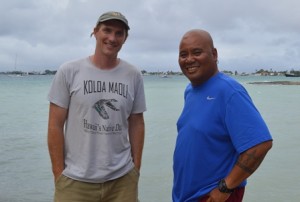
University of Hawaii’s Joe Genz with WAM director Alson Kelen. Photo: Karen Earnshaw
Joe Genz and Alson Kelen were extremely excited that the scientists came and tried to figure out the wave patterns. “I can also see how the canoes and their voyages have started to inspire people,” said Joe. “On Tabol, there were kids on the beach looking at the canoe and saying ‘What’s that?’ The villager leader, in both his welcome and farewell speeches, spoke of how he wishes to one day have a fleet of canoes lining their beach.
“The next step, I think, is that this canoe should be sailed as much as possible and we will continue to study the ‘dilep’.
“And Korent and Alson want to sail to their home atolls of Rongelap and Bikini, but these are big goals. One good thing is that after the Aur voyage, Binton now has a good sense of how the canoe needs fixing so it will be easier to sail in the ocean.”
The ongoing navigation and canoe revival efforts are being made possible by a grant from the US Ambassador’s Fund for Cultural Preservation and the National Geographic’s Genographic Legacy Fund. The University of Hawaii Hilo’s Department of Anthropology also assisted with travel funds for Joe. “We thank everyone who helped us, including the permission to sail to Aur, and hope that their support, and that of others, will continue as we help Captain Korent seek the answers to this ancient Marshallese knowledge,” said Joe. “Wave navigation is one of many traditional Marshallese practices that may help guide the Marshallese as they navigate their way through the 21st century. ”
Alson would also like to recognize the RMI National Training Council for its ongoing support of WAM and especially its training programs. “Komol tata to all those who support us!”
